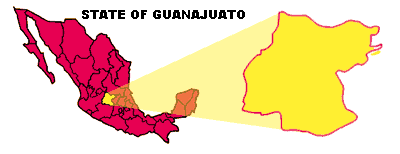 POSTCARD
from Mexico N°16
POSTCARD
from Mexico N°16 POSTCARD
from Mexico N°16
POSTCARD
from Mexico N°16
(By Fernando Rivadavia, July 11-13, 2006)
Colonial History, Mummies & Pinguicula in Guanajuato

From July 11-13, 2006, I visited the lovely historical town of Guanajuato in central Mexico. I was in fact visiting a customer in a nearby town called Irapuato – but why stay there when I could stay 1/2h away in Guanajuato? During colonial times, Guanajuato produced up to 20% of the world’s silver and the city center is packed with beautiful churches, theaters, and mansions. Numerous crude tunnels for cars (& even for busses!) criss-cross underneath the city, like some Disneyworld ride. I thoroughly enjoyed wandering aimlessly through the cobble-stone streets & narrow alleys of Guanajuato. One of the highlights was the Museum of Mummies, where exceptionally well-preserved human bodies from the city’s cemetery are exposed – a result of natural mummification processes due to the dryness of the region.
|
The town of Guanajuato
Photo : F. Rivadavia |
Two Mummies from the museum of Mummies of Guanajuato.
Photo : F. Rivadavia |
Although a lovely town, I admit my interests in Guanajuato were not purely historical… Nearly 3 years ago I discovered a large population of P.macrophylla on nearby mountains (see postcard #2). The plants were almost completely dormant then with one or two large spatulate summer leaves still present, arising from a compact onion-like dormant bud buried a few centimeters deep in the soil. Since P.macrophylla flowers in the summer, it was high on my priority list during this latest visit to Mexico.
.jpg) |
Pinguicula macrophylla : winter leaves and summer leaves as found in November 2003 in postcard N°2
Photo : Fernando Rivadavia - November 2003 -
|
As soon as I got a chance, I drove from Guanajuato out into the hills and back to that P.macrophylla site. As I walked into the partially shaded oak forest and looked up the hillside, I was rewarded with the view of countless purple flowers dotting the hillside. I’d apparently caught P.macrophylla at the peak of its flowering season! The flowers were mostly dark purple, although some were lighter in color and I even found one plant that had nearly white petals. The throat of the corolla was a very dark purple, a large white stripe was present on the base of the central lower lobe, and a few thin white streaks were sometimes present at the base of other lobes. There was also a little variation in the shape of the corolla lobes, but only in that some were slightly wider than others. The calyx lobes and flower scapes varied from light green to reddish in color. The rosettes were mostly light-green, but some were dark green, maybe slightly reddish. I was surprised at how robust the scapes were and how each plant had up to 4 scapes per plant – that’s a lot of energy invested into flowering!
P.macrophylla grew mostly on mossy banks in the more inclined parts of the hillside, where oaks leaves tended to slip past and not accumulate (and thus shadow the plants). The soil was surprisingly dry, only barely humid. When I was in Mexico during the winter dry season of 2003-2004, I thought it was natural that the soil at most Pinguicula habitats was dry, but expected it to be wet during the summer. Now I am discovering that even during the wet season the soil is still very dry for most species and that Mexican Pinguicula are grown too wet by most CPers!
Exploring a bit further along the road, I found a massive P.macrophylla population, covered in flowers, while climbing another hillside. I also found numerous plants in flower on banks along the roadside. It may be what Eric calls a “lazy” CP site, but certainly not safe! There was only a small space for one to stand between the road and the cars speeding around the corner!
|
A “lazy” CP site, but certainly not safe! Photo : F.Rivadavia |
Pinguicula macrophylla flowering in habitat. Photo : F.Rivadavia |
On my way out from Guanajuato, before driving back south to Mexico City, I first drove north towards Aguascalientes to explore a road between Lagos de Moreno & León, where one of the three known collections of U.perversa was made. Although a very desertic region, strangely enough there are several lakes & ponds spread around this region. I stopped by a few but the water seemed very still and dirtied from being used too often by cows. And therefore, for the time being, we will unfortunately continue to know U.perversa only from a few dried specimens.
Fernando Rivadavia.